Climate Extremes over the Arabian Peninsula Using RegCM4 for Present Conditions Forced by Several CMIP5 Models
Abstract
1. Introduction
2. Data and Methodology
2.1. Data
2.2. Methodology
2.2.1. Regional Climate Model and Experimental Setup
- Step (i) was repeated using the CLM land–surface scheme.
- RegCM4 was forced with GFDL using BATS for the period 1970–2005 (with 1970 used as spin–up time).
- Step (iii) was repeated using the CLM land–surface scheme.
- RegCM4 was forced with HadGEM output using BATS for the period 1960–2005 (with 1960 used as spin–up time).
- Step (v) is repeated using the CLM land–surface scheme.
- RegCM4 was forced with ECHAM6 output using BATS for the period 1960–2005 (with 1960 used as spin–up time).
- Step (vii) was repeated using the CLM land–surface scheme.
2.2.2. Analysis Procedure
- Warm days (TX90p, a percentile index calculated from daily maximum temperature),
- Warm nights (TN90p, a percentile index calculated from daily minimum temperature),
- Cold days (TX10p, a percentile index calculated from daily maximum temperature),
- Cold nights (TN10p, a percentile index calculated from daily minimum temperatures),
- Warm spell duration (WSDI, an index is calculated from daily maximum temperatures),
- Cold spell duration (CSDI, an index calculated from daily minimum temperature),
- Number of wet days (R1mm, number of wet days is a threshold index calculated from daily precipitation),
- Consecutive wet days (CWD, a threshold index calculated from daily precipitation),
- Consecutive dry days (CDD, a threshold index calculated from daily precipitation) from the climate model data for the study region.
3. Results and Discussion
3.1. Temperature and Precipitation Simulations
3.1.1. Temperature Simulation
3.1.2. Precipitation Simulation
3.2. Climate Extremes Indices
3.2.1. Observation-Based Climate Extremes
3.2.2. Simulation-Based Climate Extremes
3.2.3. Temperature Extremes
3.2.4. Annual Time Series for the Extreme Indices Averaged over the Observational Grids
3.2.5. Precipitation Extremes
3.3. Selection of CMIP5 Models
4. Conclusions
Supplementary Materials
Funding
Acknowledgments
Conflicts of Interest
References
- Sun, Q.; Miao, C.; Duan, Q. Extreme climate events and agricultural climate indices in China: CMIP5 model evaluation and projections. Int. J. Climatol. 2016, 36, 43–61. [Google Scholar] [CrossRef]
- IPCC. A Special Report of Working Groups I and II of the Intergovernmental Panel on Climate Change: Managing the Risks of Extreme Events and Disasters to Advance Climate Change Adaptation–Summary for Policymakers; Cambridge University Press: Cambridge, UK, 2013. [Google Scholar]
- IPCC. Climate Change 2007. The Physical Sciences Basis Contribution of Working Group 1 to the Fourth Assessment Report of the Intergovernmental Panel on Climate Change; Solomon, S., Qin, D., Manning, M., Chen, Z., Marquis, M., Averyt, K.B., Tignor, M., Miller, H.L., Eds.; Cambridge University Press: Cambridge, UK, 2007; p. 4. [Google Scholar]
- Almazroui, M.; Islam, M.N.; Athar, H.; Jones, P.D.; Rahman, M.A. Recent climate change in the Arabian Peninsula: Annual rainfall and temperature analysis of Saudi Arabia for 1978–2009. Int. J. Climatol. 2012, 32, 953–966. [Google Scholar] [CrossRef]
- Almazroui, M.; Islam, M.N.; Jones, P.D. Urbanization effects on the air temperature rise in Saudi Arabia. Clim. Chang. 2013, 120, 109–122. [Google Scholar] [CrossRef]
- Almazroui, M. Temperature changes over the CORDEX-MENA domain in the 21st century using CMIP5 data downscaled with RegCM4: A focus on the Arabian Peninsula. Advan. Meteorol. 2019, 18. [Google Scholar] [CrossRef]
- Atif, R.M.; Almazroui, M.; Saeed, S.; Abid, M.A.; Islam, M.N.; Ismail, M. Extreme precipitation events over Saudi Arabia during the wet season and their associated teleconnections. Atmos. Res. 2019, 231, 104655. [Google Scholar] [CrossRef]
- Saeed, S.; Almazroui, M. Impacts of mid-latitude circulation on winter precipitation over the Arabian Peninsula. Clim. Dyn. 2019. [Google Scholar] [CrossRef]
- Almazroui, M.; Saeed, S. Contribution of extreme daily precipitation to total rainfall over the Arabian Peninsula. Atmos. Res. 2019. [Google Scholar] [CrossRef]
- Easterling, D.; Meehl, G.A.; Parmesan, C.; Changnon, S.A.; Karl, T.R.; Mearns, L.O. Climate Extremes: Observations, Modeling, and Impacts. Science 2000, 289, 2068–2074. [Google Scholar] [CrossRef]
- AlSarmi, S.H.; Washington, R. Review Changes in climate extremes in the Arabian Peninsula: Analysis of daily data. Int. J. Climatol. 2013, 34, 1329–1345. [Google Scholar] [CrossRef]
- Almazroui, M.; Islam, M.N.; Dambul, R.; Jones, P.D. Trends of temperature extremes in Saudi Arabia. Int. J. Climatol. 2014, 34, 808–826. [Google Scholar] [CrossRef]
- Donat, M.G.; Peterson, T.C.; Brunet, M.; King, A.D.; Almazroui, M.; Kolli, R.K.; Boucherf, D.; Al-Mulla, A.Y.; Nour, A.Y.; Aly, A.A.; et al. Changes in extreme temperature and precipitation in the Arab region: Long-term trends and variability related to ENSO and NAO. Int. J. Climatol. 2014, 34, 581–592. [Google Scholar] [CrossRef]
- Islam, M.N.; Almazroui, M.; Dambul, R.; Jones, P.D.; Alamoudi, A.O. Long-term changes in seasonal temperature extremes over Saudi Arabia during 1981–2010. Int. J. Climatol. 2015, 35, 1579–1592. [Google Scholar] [CrossRef]
- You, Q.; Ren, G.; Fraedrich, K.; Kang, S.; Ren, Y.; Wang, P. Winter temperature extremes in China and their possible Causes. Int. J. Climatol. 2013, 33, 1444–1455. [Google Scholar] [CrossRef]
- Alexander, L.V.; Zhang, X.; Peterson, T.C.; Caesar, J.; Gleason, B.; Klein Tank, A.M.G.; Haylock, M.; Collins, D.; Trewin, B.; Rahimzadeh, F.; et al. Global observed changes in daily climate extremes of temperature and precipitation. J. Geophy. Res. 2006, 111, D05109. [Google Scholar] [CrossRef]
- Sillmann, J.; Kharin, V.V.; Zhang, X.; Zwiers, F.W.; Bronaugh, D. Climate extremes indices in the CMIP5 multimodel ensemble: Part 1. Model evaluation in the present climate. J. Geophy. Res. Atmos. 2013, 118, 1716–1733. [Google Scholar] [CrossRef]
- Sillmann, J.; Kharin, V.V.; Zwiers, F.W.; Zhang, X.; Bronaugh, D. Climate extremes indices in the CMIP5 multimodel ensemble: Part 2. Future climate projections. J. Geophy. Res. Atmos. 2013, 118, 2473–2493. [Google Scholar] [CrossRef]
- Tank, A.M.G.; Zwiers, F.W.; Zhang, X. Guidelines on Analysis of Extremes in a Changing Climate in Support of Informed Decisions for Adaptation; Climate Data and Monitoring 2009, WCDMP-No. 72. World Meteorological Organization WMO-TD No. 1500; World Meteorological Organization: Geneva, Switzerland, 2009. [Google Scholar]
- Karl, T.R.; Easterling, D. Climate Extremes: Selected Review and Future Research Directions. Clim. Chang. 1999, 42, 309–325. [Google Scholar] [CrossRef]
- Revadekar, J.V.; Hameed, S.; Collins, D.; Manton, M.; Sheikh, M.M.; Borgaonkar, H.P.; Kothawale, D.R.; Adnan, M.; Ahmed, A.U.; Ashraf, J.; et al. Impact of altitude and latitude on changes in temperature extremes over South Asia during 1971–2000. Int. J. Climatol. 2012, 33, 192–209. [Google Scholar] [CrossRef]
- Wheeler, T.; Braun, v.J. Climate Change Impacts on Global Food Security. Science 2013, 341, 508–513. [Google Scholar] [CrossRef]
- Tsikerdekis, A.; Zanis, P.; Georgoulias, A.K.; Alexandri, G.; Katragkou, E.; Karacostas, T.; Solmon, F. Direct and semi-direct radiative effect of North African dust in present and future regional climate simulations. Clim. Dyn. 2019, 53, 4311–4336. [Google Scholar] [CrossRef]
- Giorgi, F.; Coppola, E.; Solmon, F.; Mariotti, L.; Sylla, M.B.; Bi, X.; Elguindi, N.; Diro, G.T.; Nair, V.; Giuliani, G.; et al. RegCM4: Model description and preliminary tests over multiple CORDEX domains. Clim. Res. 2012, 52, 7–29. [Google Scholar] [CrossRef]
- Gao, X.; Pal, J.S.; Giorgi, F. Projected changes in mean and extreme precipitation over the Mediterranean region from a high resolution double nested RCM simulation. Geophy. Res. Lett. 2006, 33, L03706. [Google Scholar] [CrossRef]
- Dickinson, R.E.; Henderson-Sellers, A.; Kennedy, P.J. Biosphere-atmosphere transfer scheme (BATS) version 1 as coupled to the NCAR community climate model. Note TH-387+ STR Natl. Cent. Atmos. Res. 1993. [Google Scholar] [CrossRef]
- Oleson, K.W.; Niu, G.Y.; Yang, Z.L. Improvements to the Community Land Model and their impact on the hydrological cycle. J. Geophys. Res. 2008, 113. [Google Scholar] [CrossRef]
- Steiner, A.L.; Pal, J.S.; Giorgi, F.; Dickinson, R.E.; Chameides, W.L. The coupling of the Common Land Model (CLM0) toaregional climate model (RegCM). Theor. Appl. Climatol. 2005. [Google Scholar] [CrossRef]
- Fritsch, J.M.; Chappell, C.F. Numerical prediction of convectively driven mesoscale pressure systems, Part I, Convective parameterization. J. Atmos. Sci. 1980, 37, 1722–1733. [Google Scholar] [CrossRef]
- Fritsch, J.M.; Chappell, C.F. Numerical Prediction of Convectively Driven Mesoscale Pressure Systems, Part II, Mesoscale Model. J. Atmos. Sci. 1980, 37, 1734–1762. [Google Scholar] [CrossRef]
- Islam, M.N.; Almazroui, M. Direct effects and feedback of desert dust on the climate of the Arabian Peninsula during the wet season: A regional climate model study. Clim. Dyn. 2012, 39, 2239–2250. [Google Scholar] [CrossRef][Green Version]
- Harris, I.; Jones, P.D.; Osborn, T.J.; Lister, D. Updated high-resolution grids of monthly climatic observations—The CRU TS3.10 Dataset. Int. J. Climatol. 2014, 34, 623–642. [Google Scholar] [CrossRef]
- Almazroui, M.; Islam, M.N.; Saeed, S.; Alkhalaf, A.K.; Dambul, R. Assessment of Uncertainties in Projected Temperature and Precipitation over the Arabian Peninsula Using Three Categories of Cmip5 Multimodel Ensembles. Earth Syst. Environ. 2017, 1, 23. [Google Scholar] [CrossRef]
- Almazroui, M.; Saeed, F.; Islam, M.N.; Alkhalaf, A.K. Assessing the robustness and uncertainties of projected changes in temperature and precipitation in AR4 Global Climate Models over the Arabian Peninsula. Atmos. Res. 2016, 182, 163–175. [Google Scholar] [CrossRef]
- Almazroui, M.; Tayeb, O.; Mashat, A.S.; Yousef, A.; Al-Turki, Y.A.; Abid, M.A.; Bafail, A.O.; Ehsan, M.A.; Zahed, A.; Rahman, M.A. Saudi-KAU coupled global climate model: Description and performance. Earth Syst. Environ. 2017, 1, 7. [Google Scholar] [CrossRef]
- Ehsan, M.A.; Almazroui, M.; Yousef, A. Impact of Different Cumulus Parameterization Schemes in Saudi-KAU AGCM. Earth Syst. Environ. 2017, 1, 3. [Google Scholar] [CrossRef]
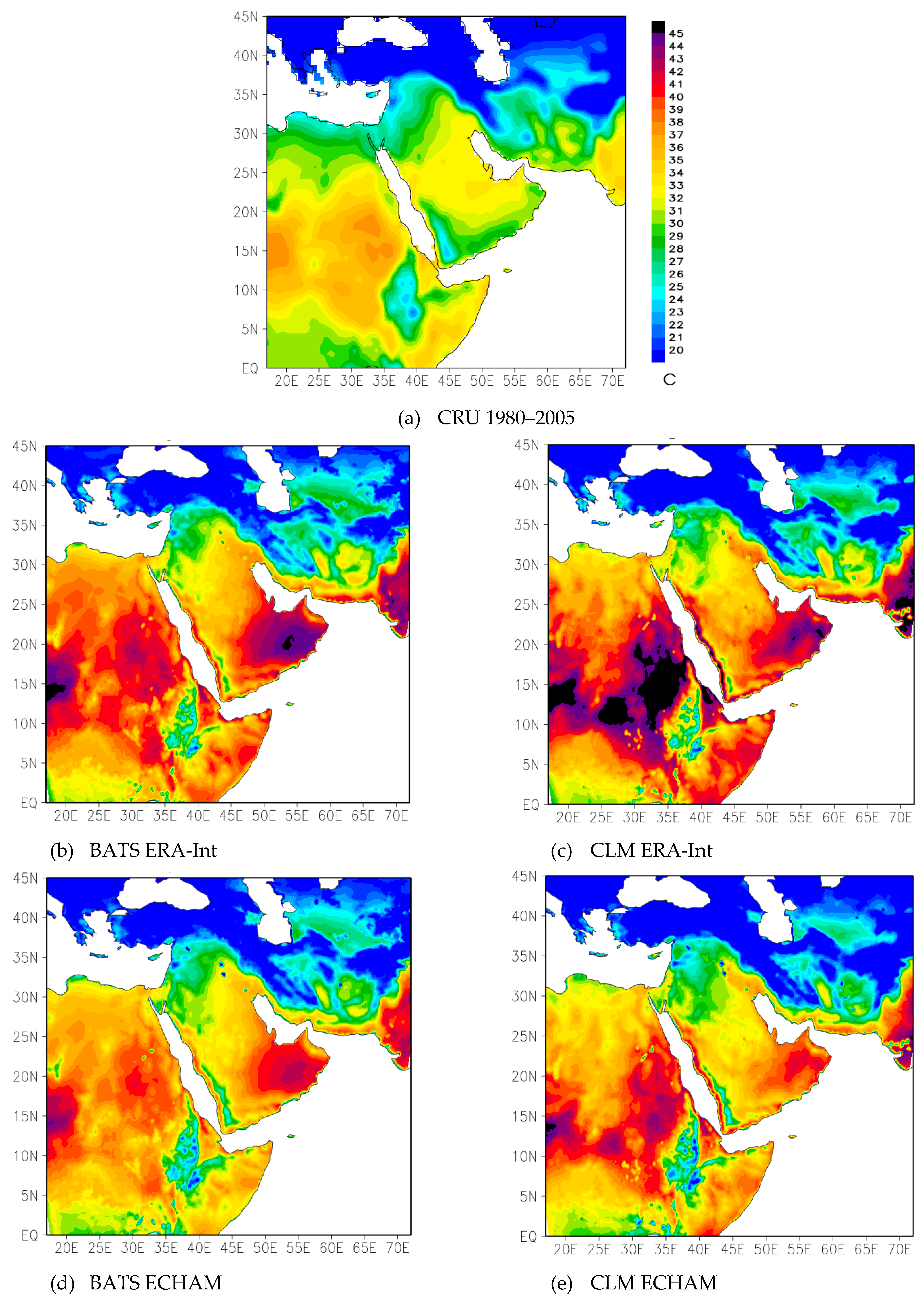
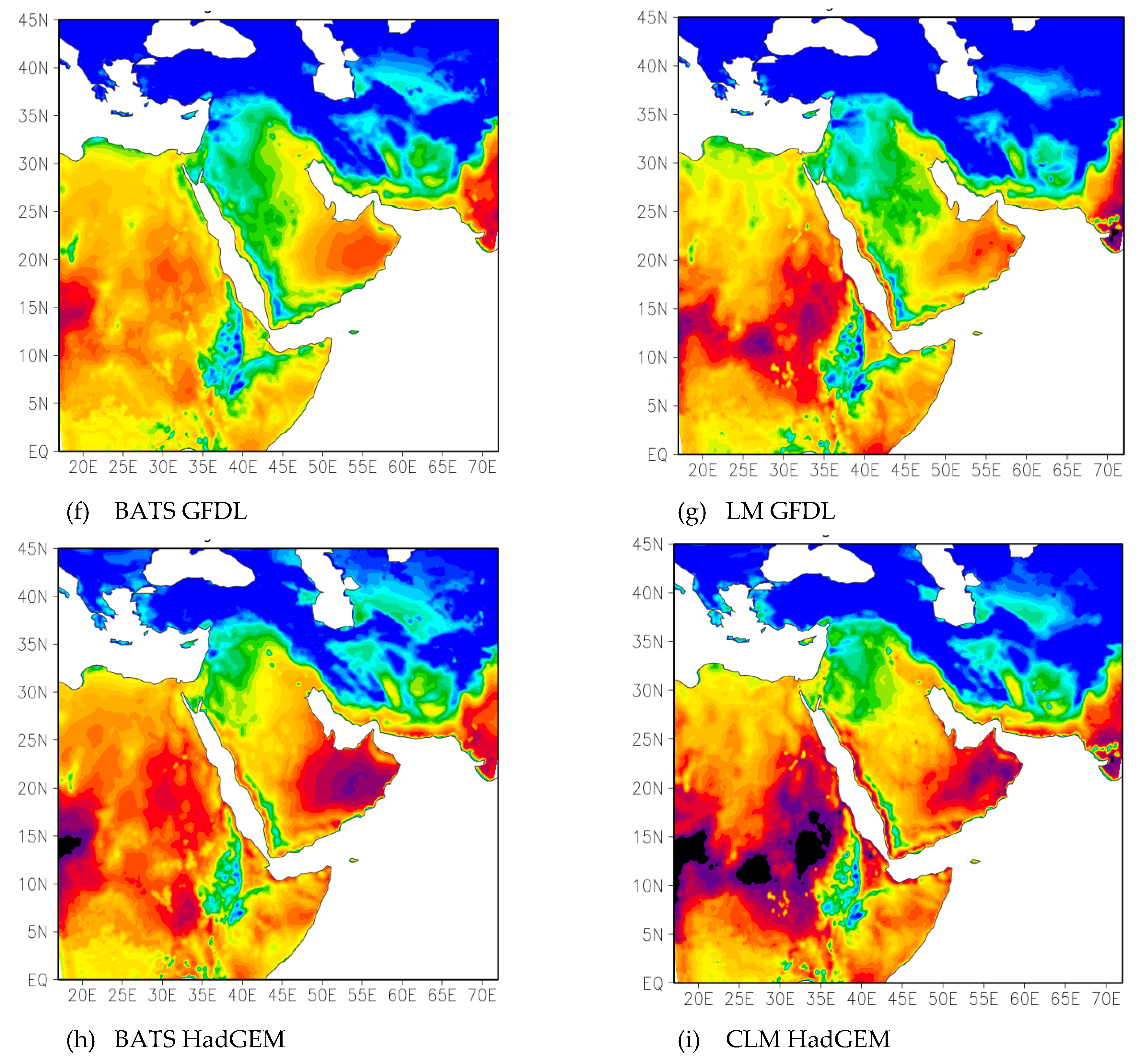
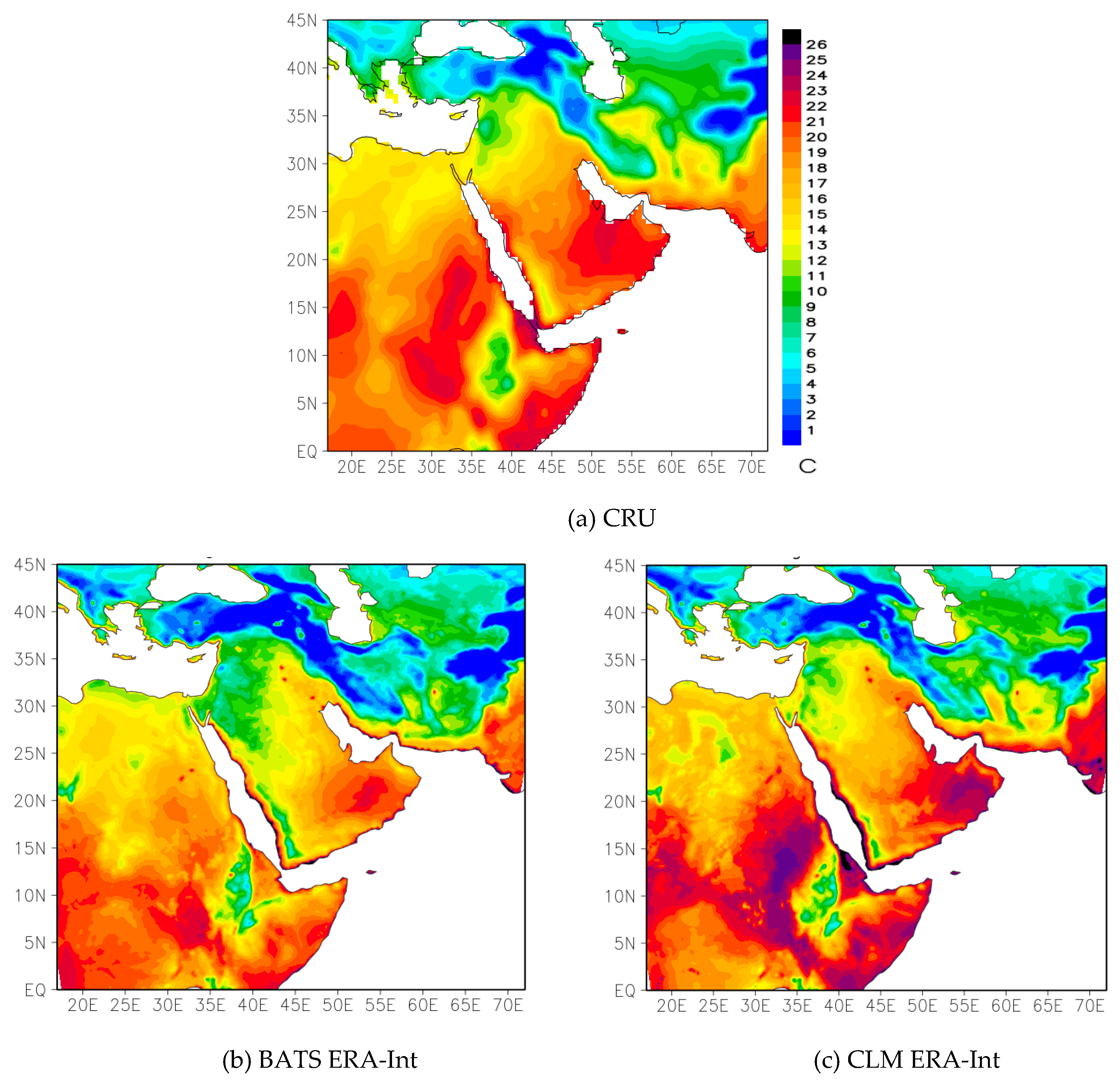
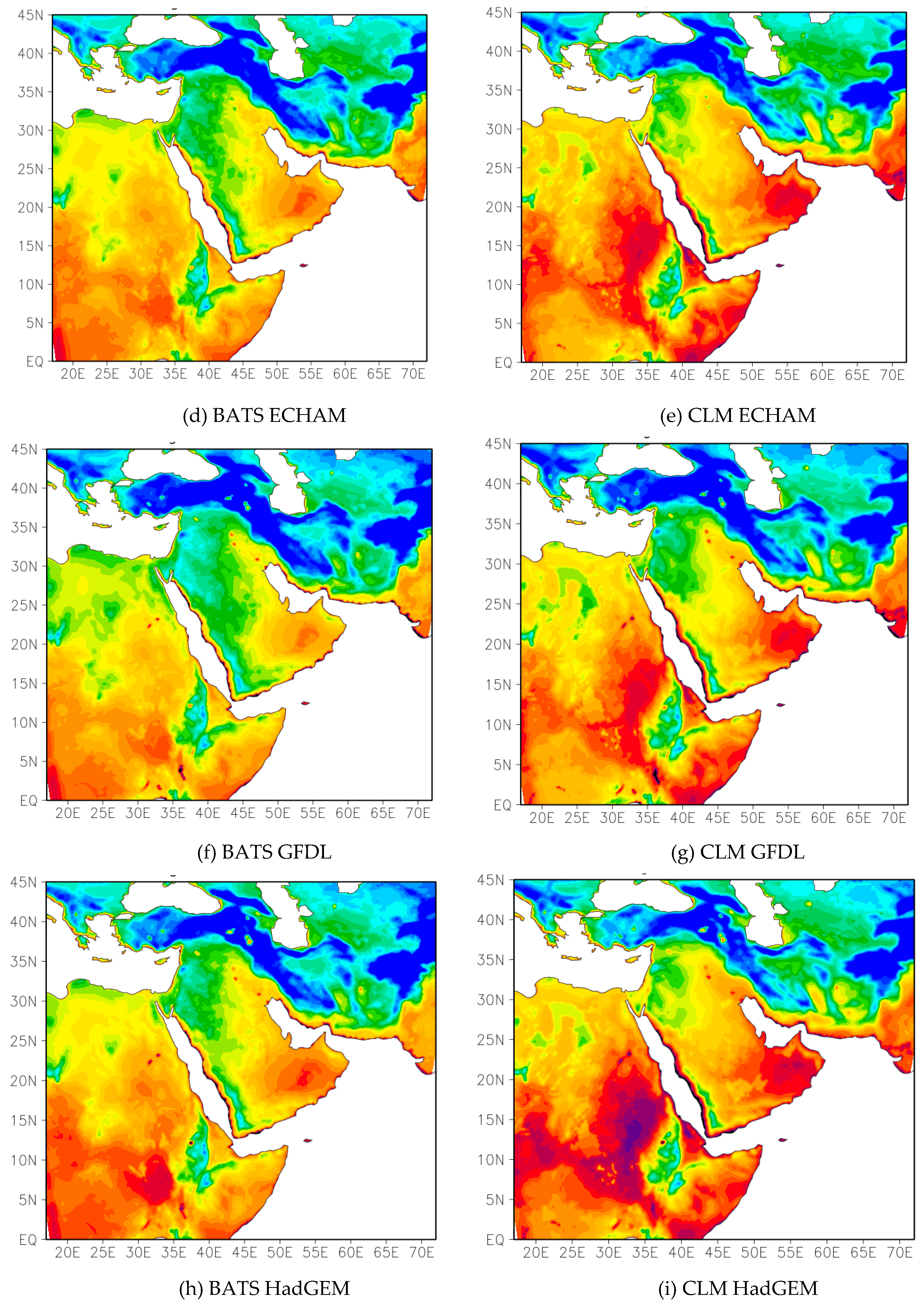
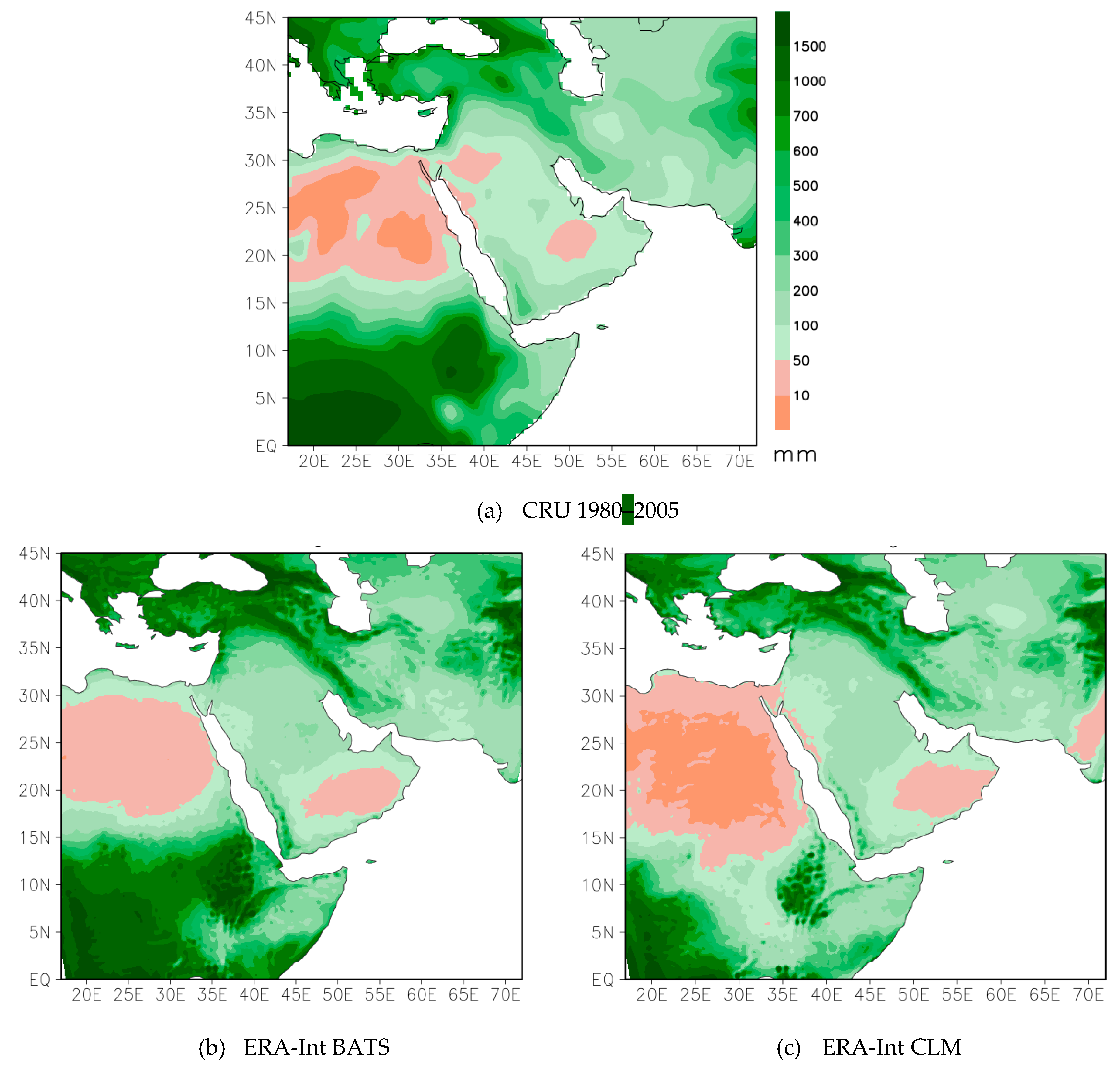
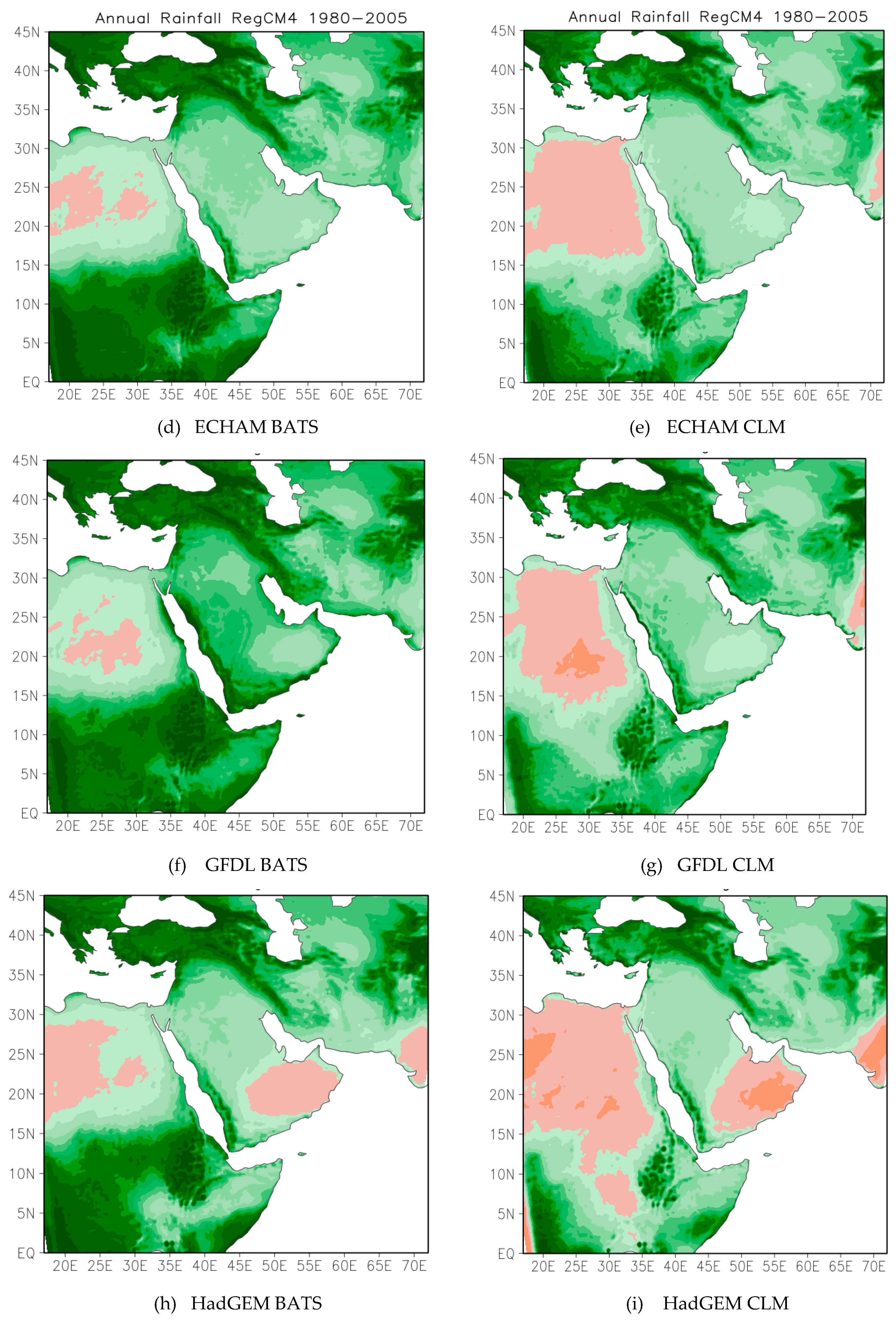
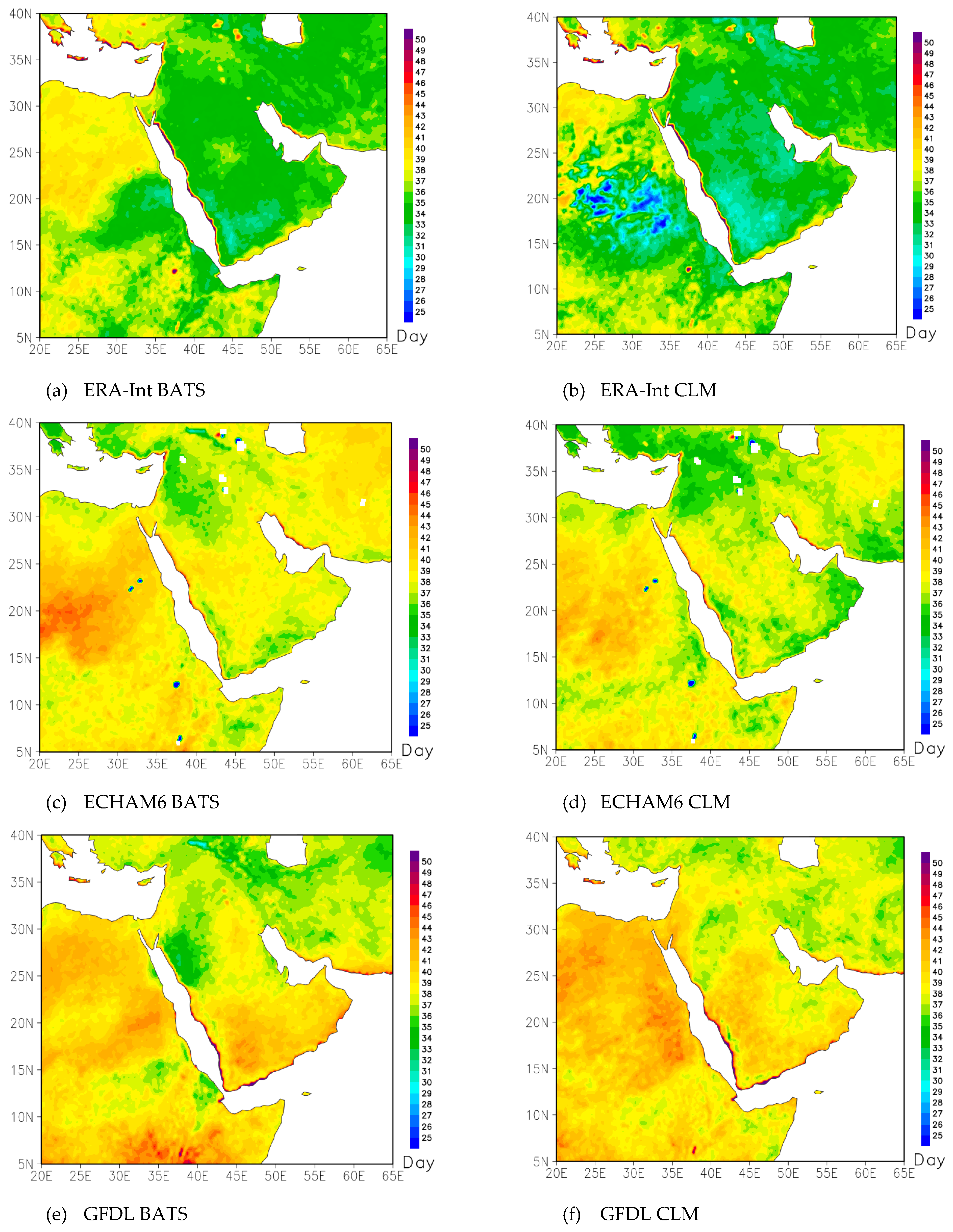

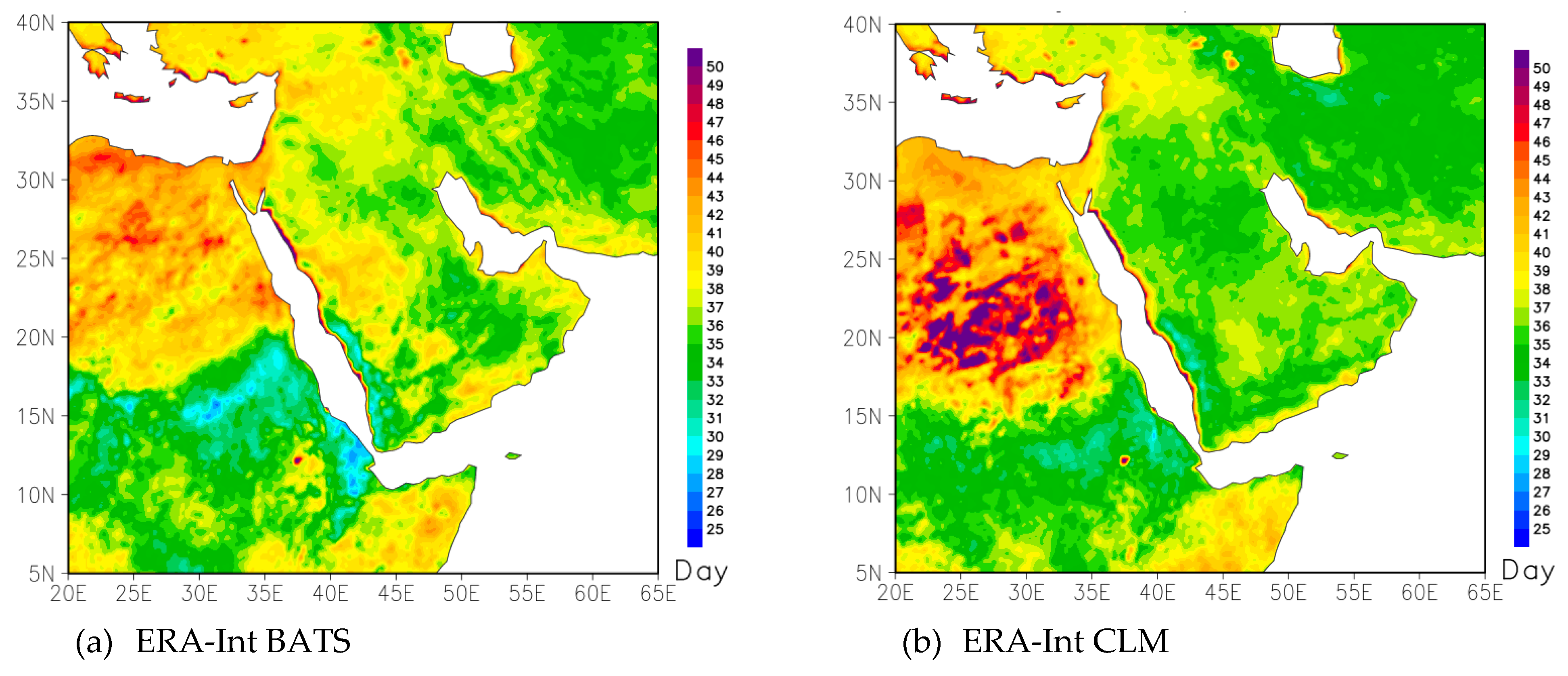
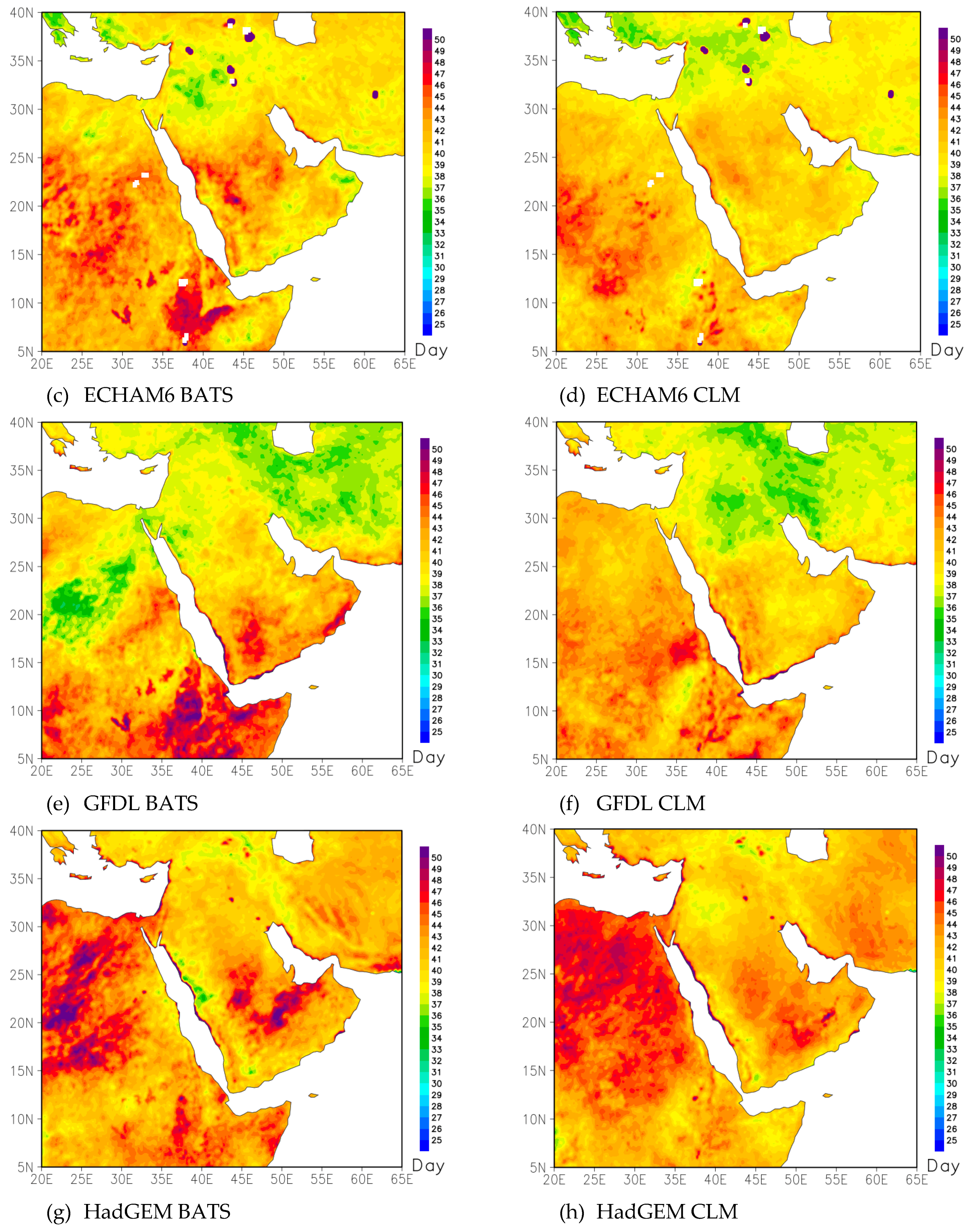
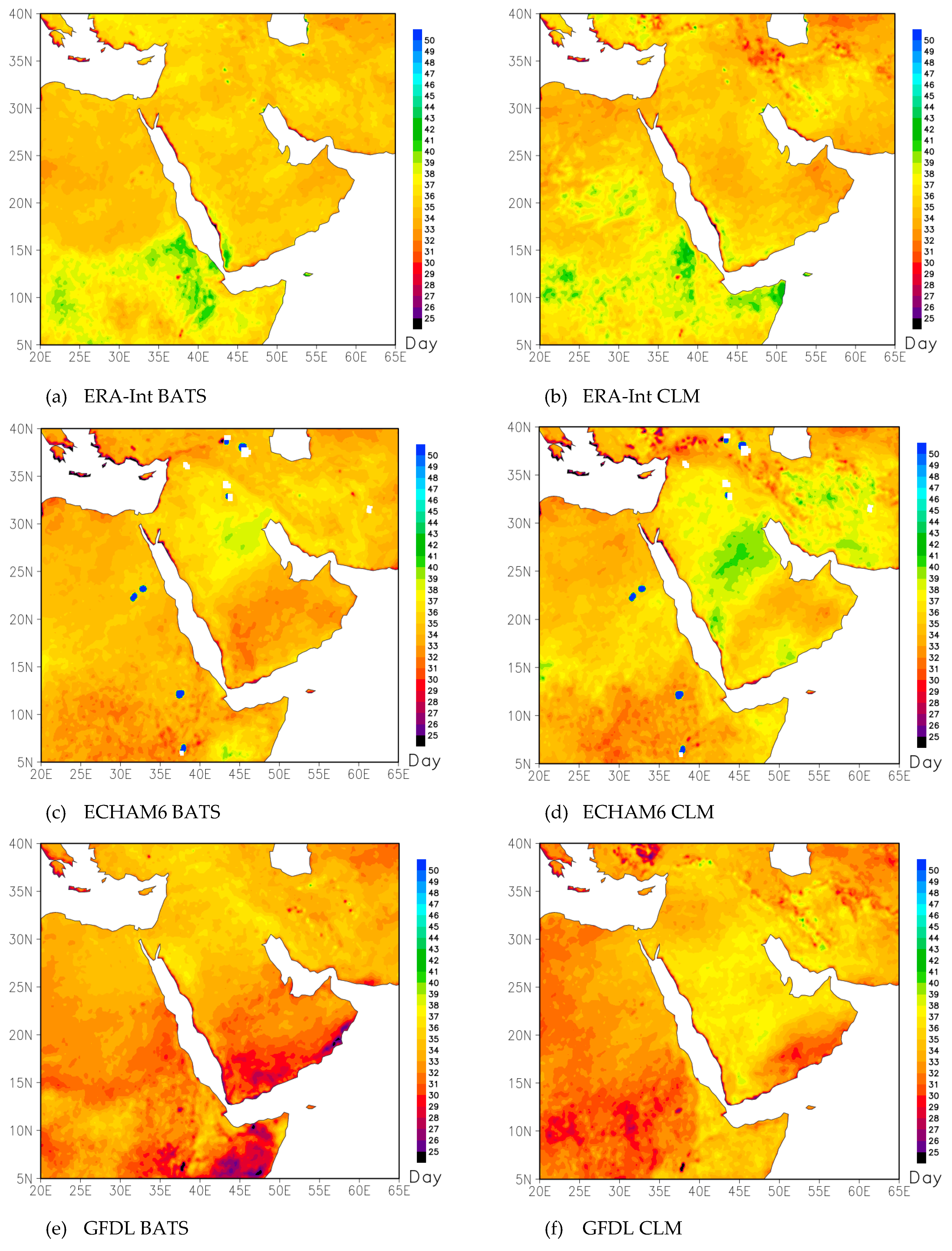
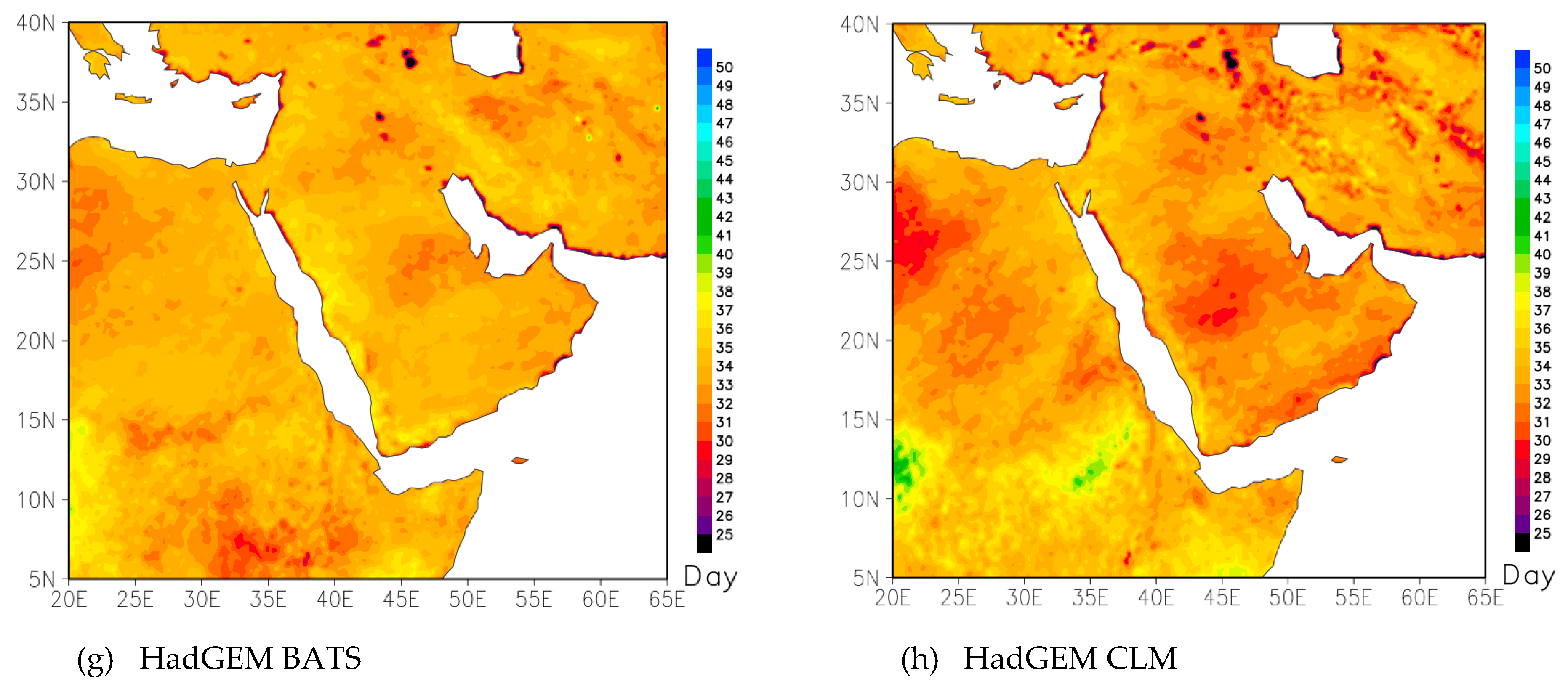

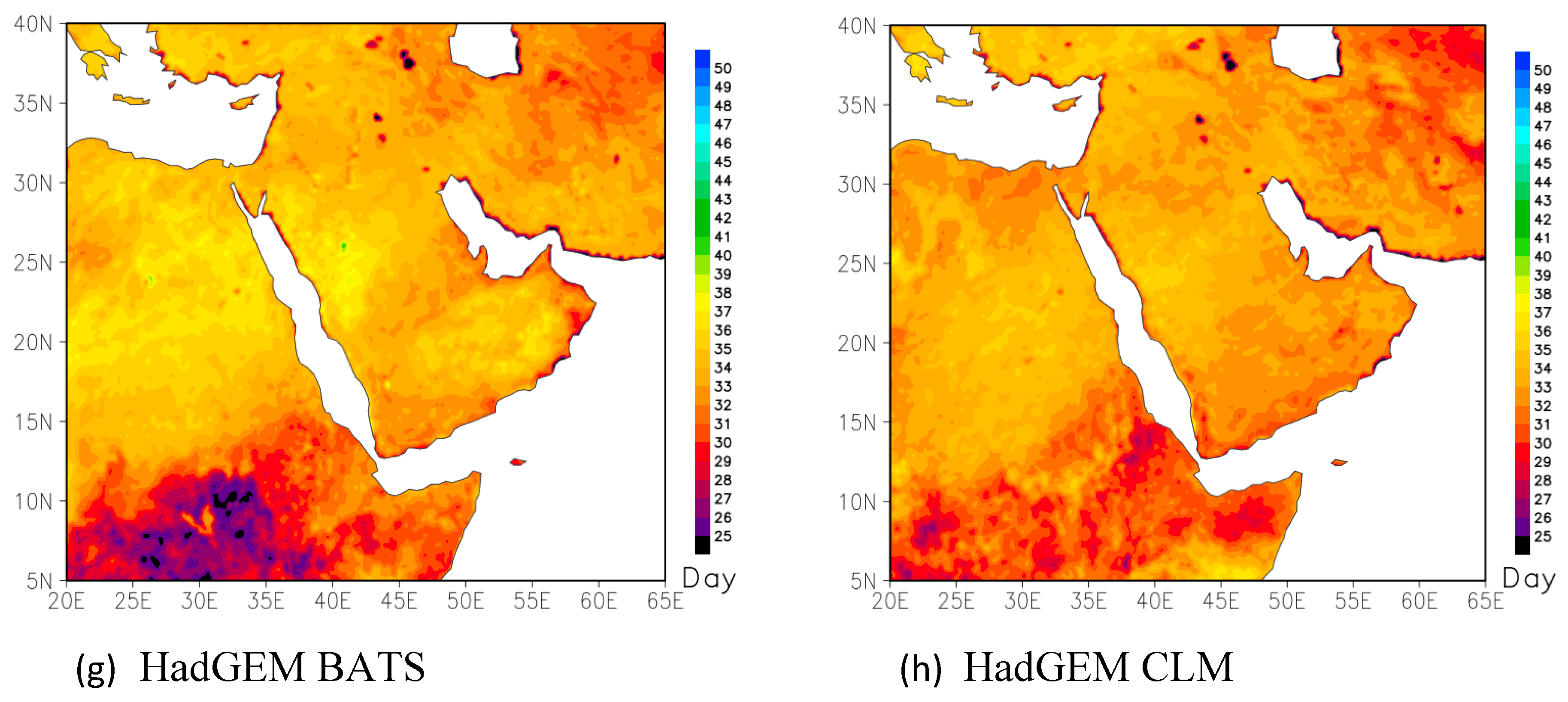

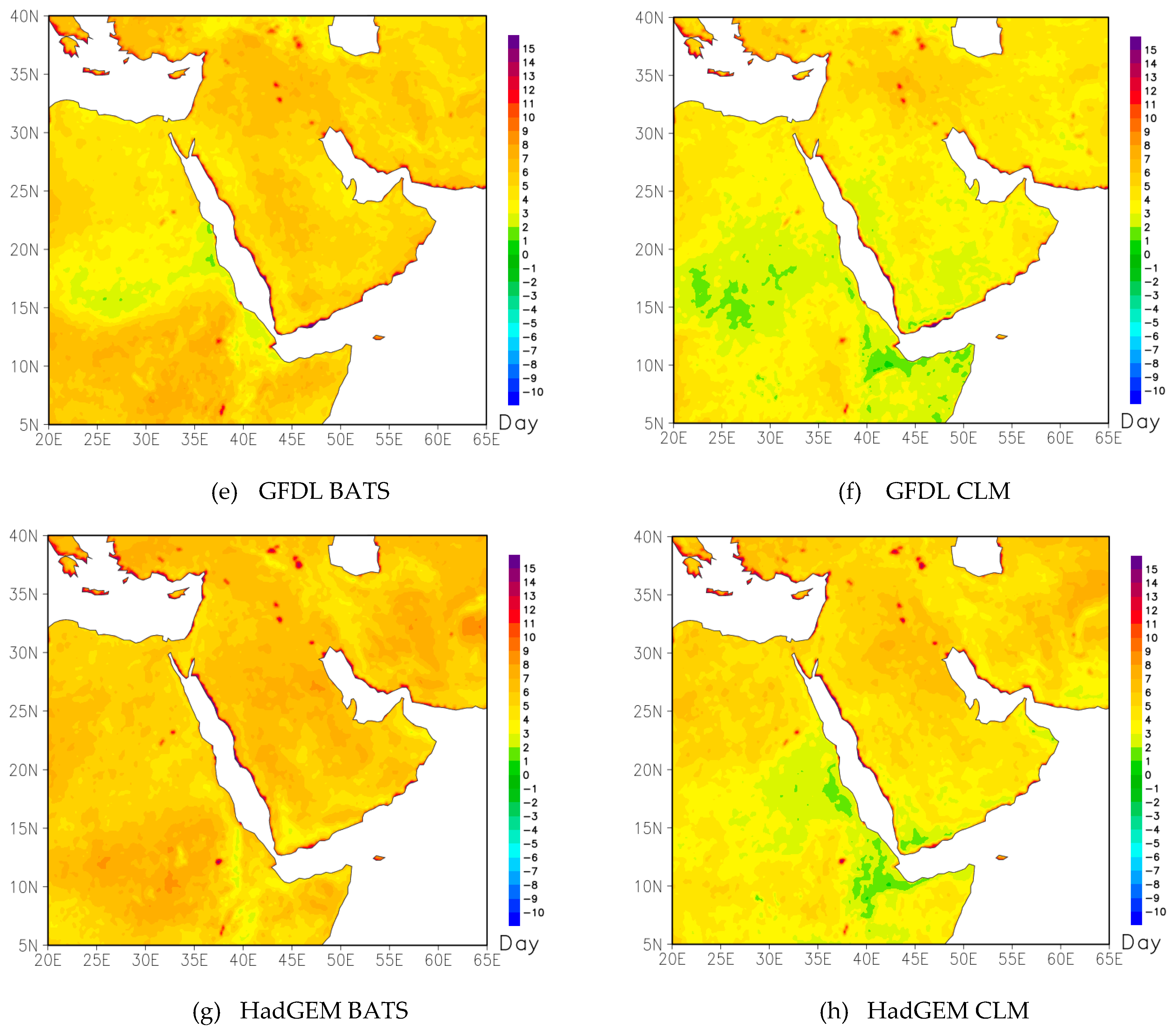
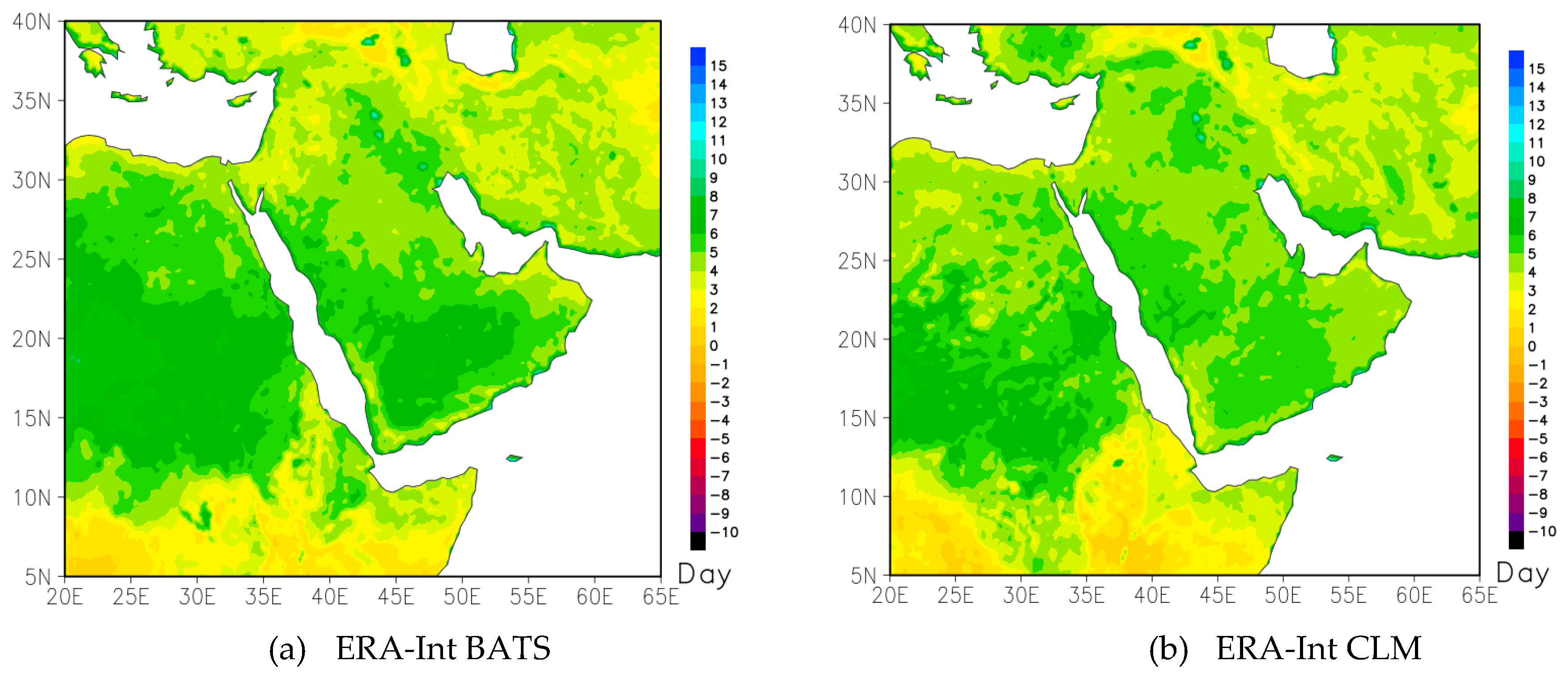
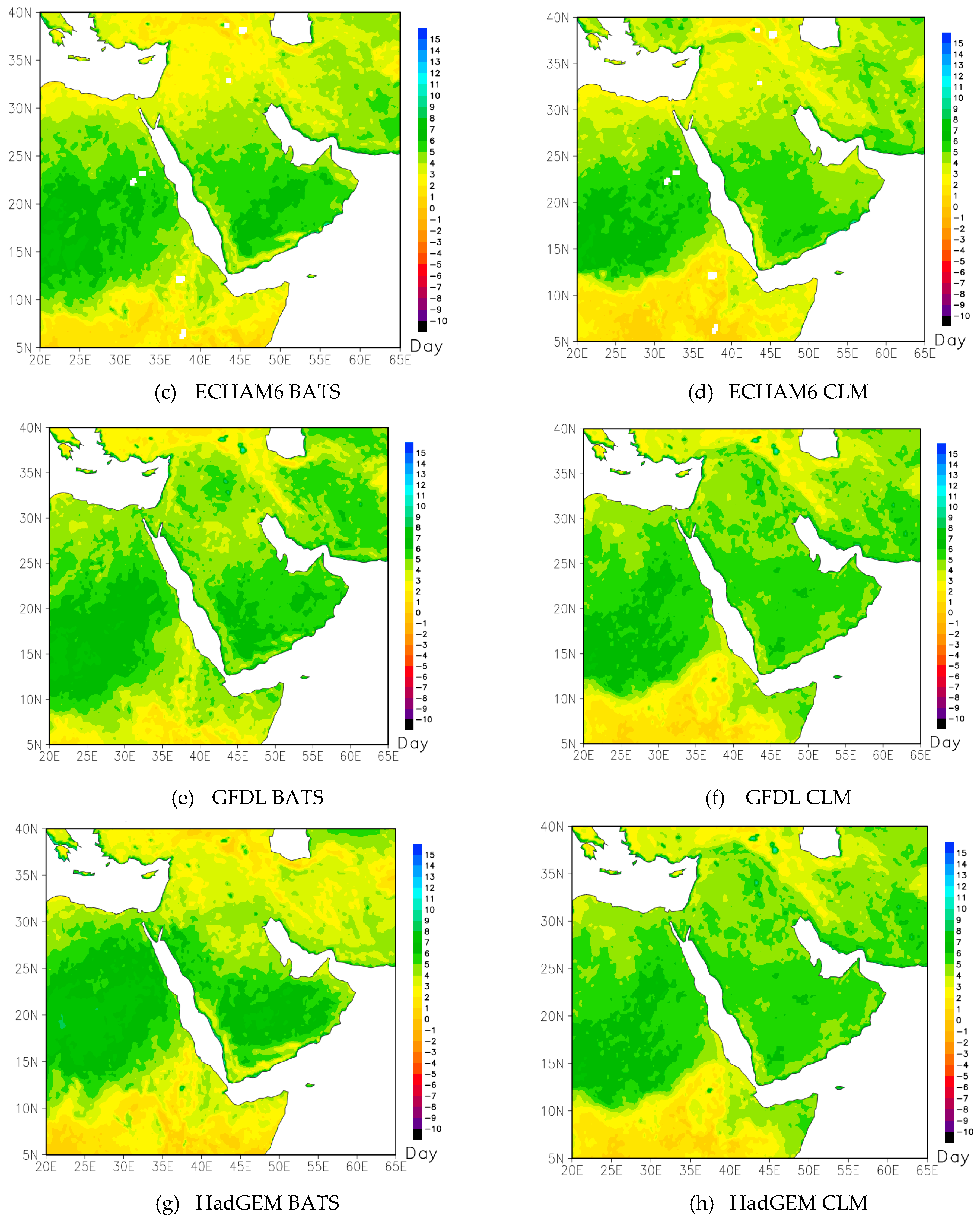
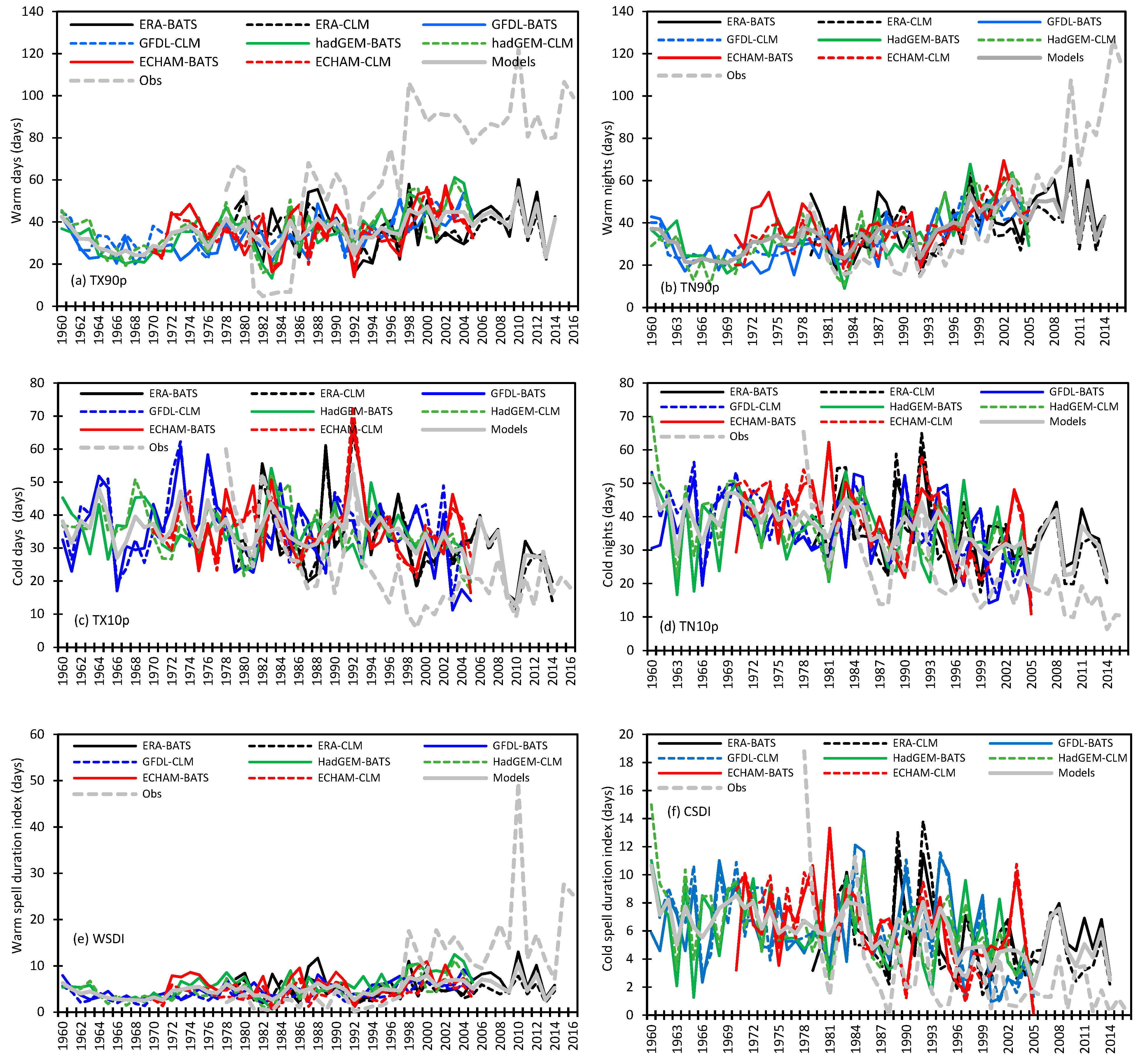


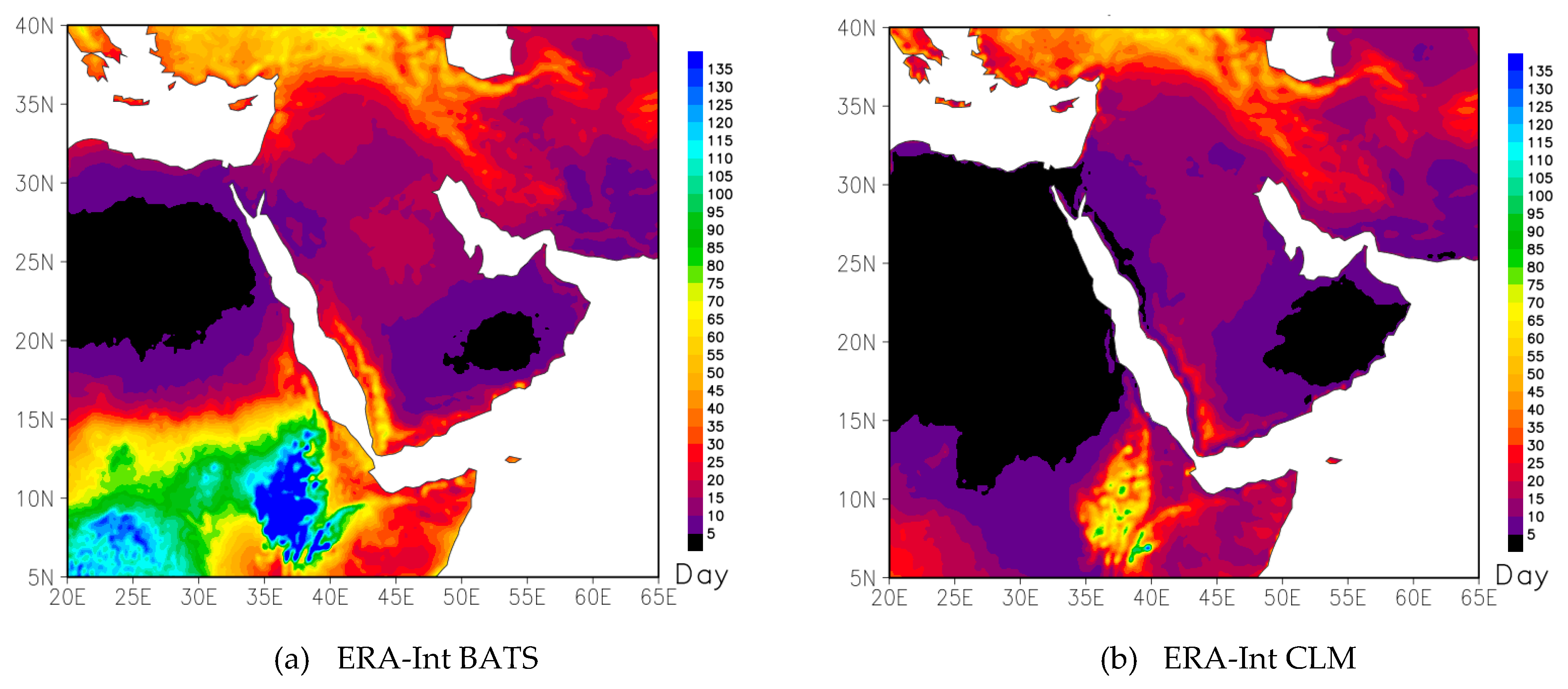
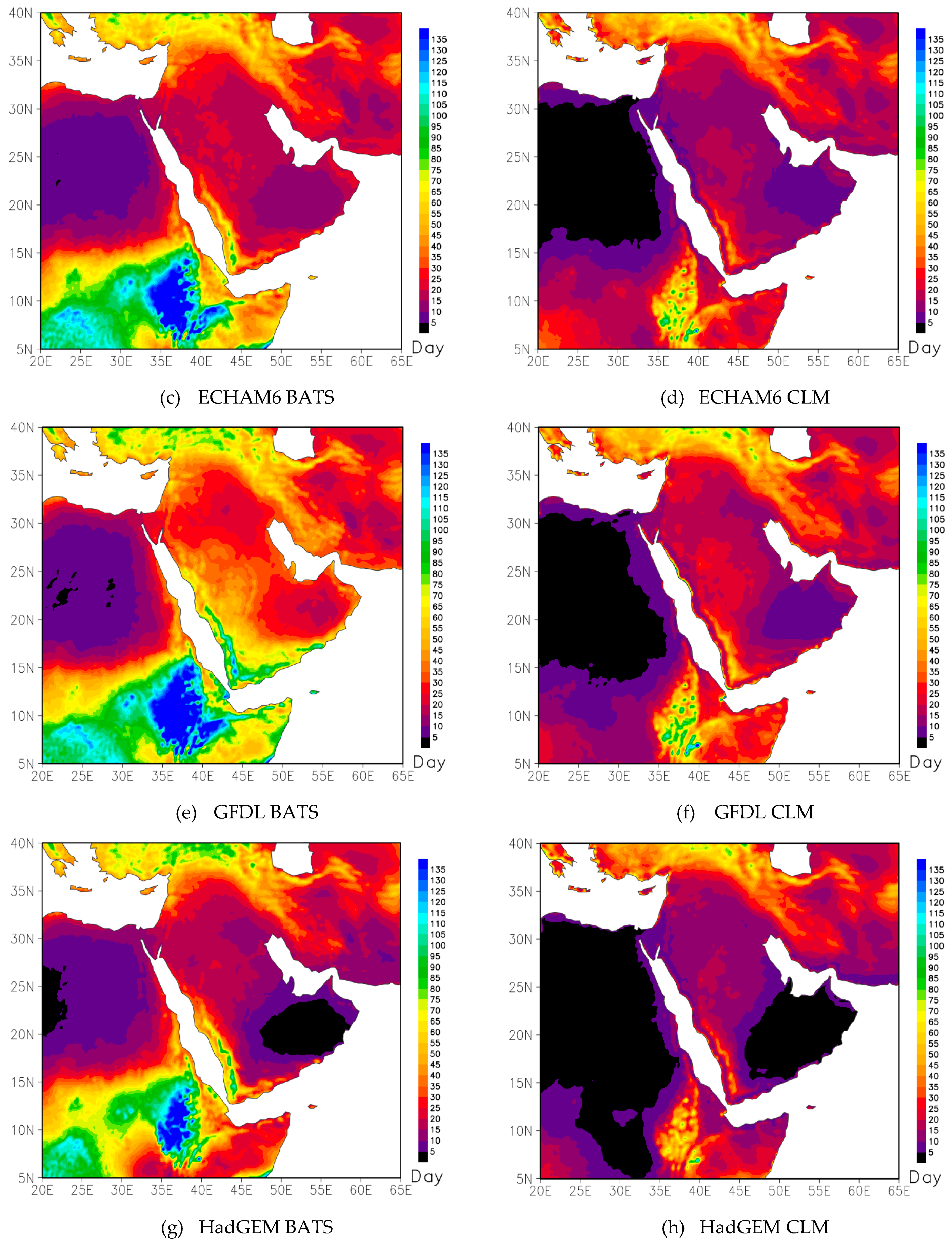
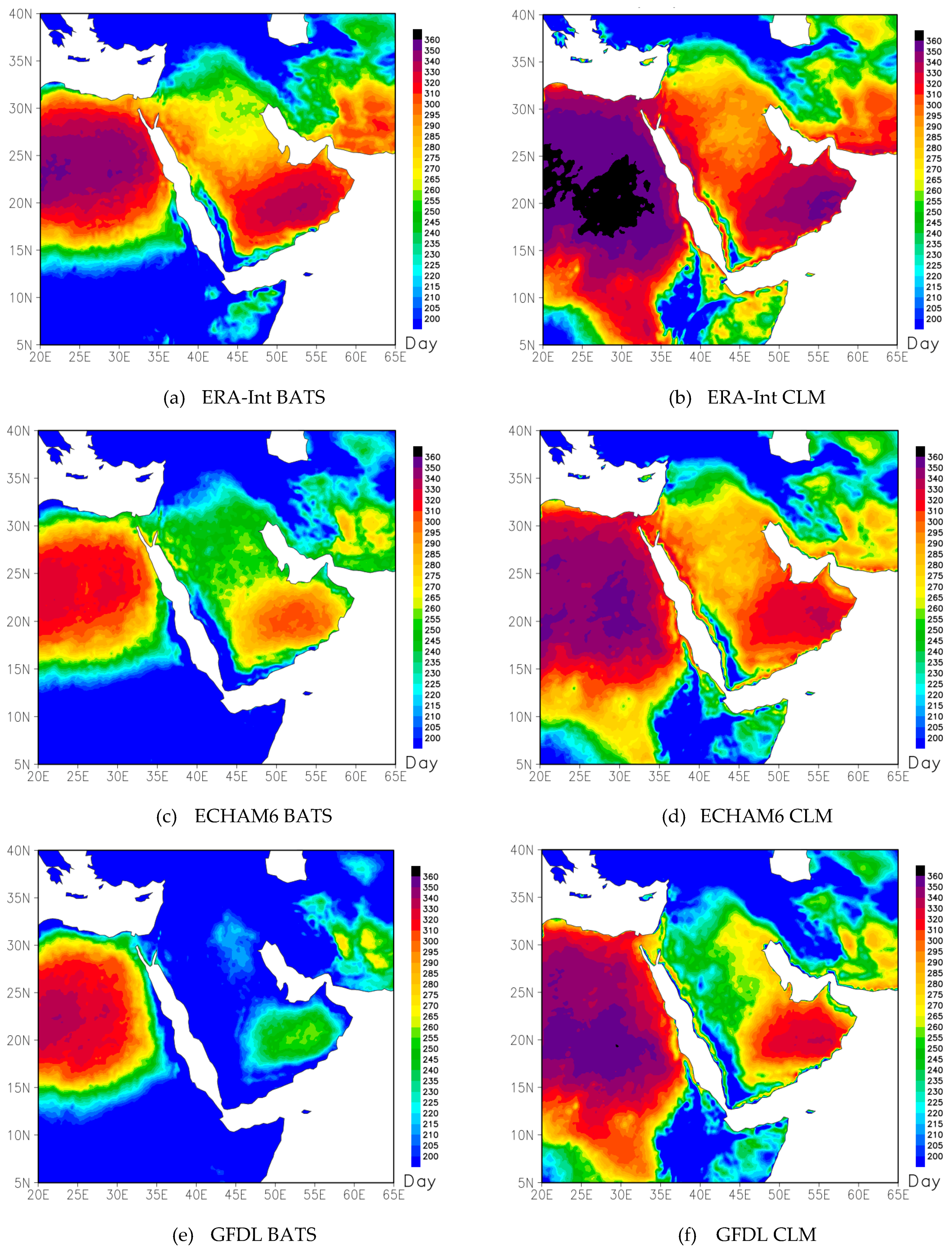
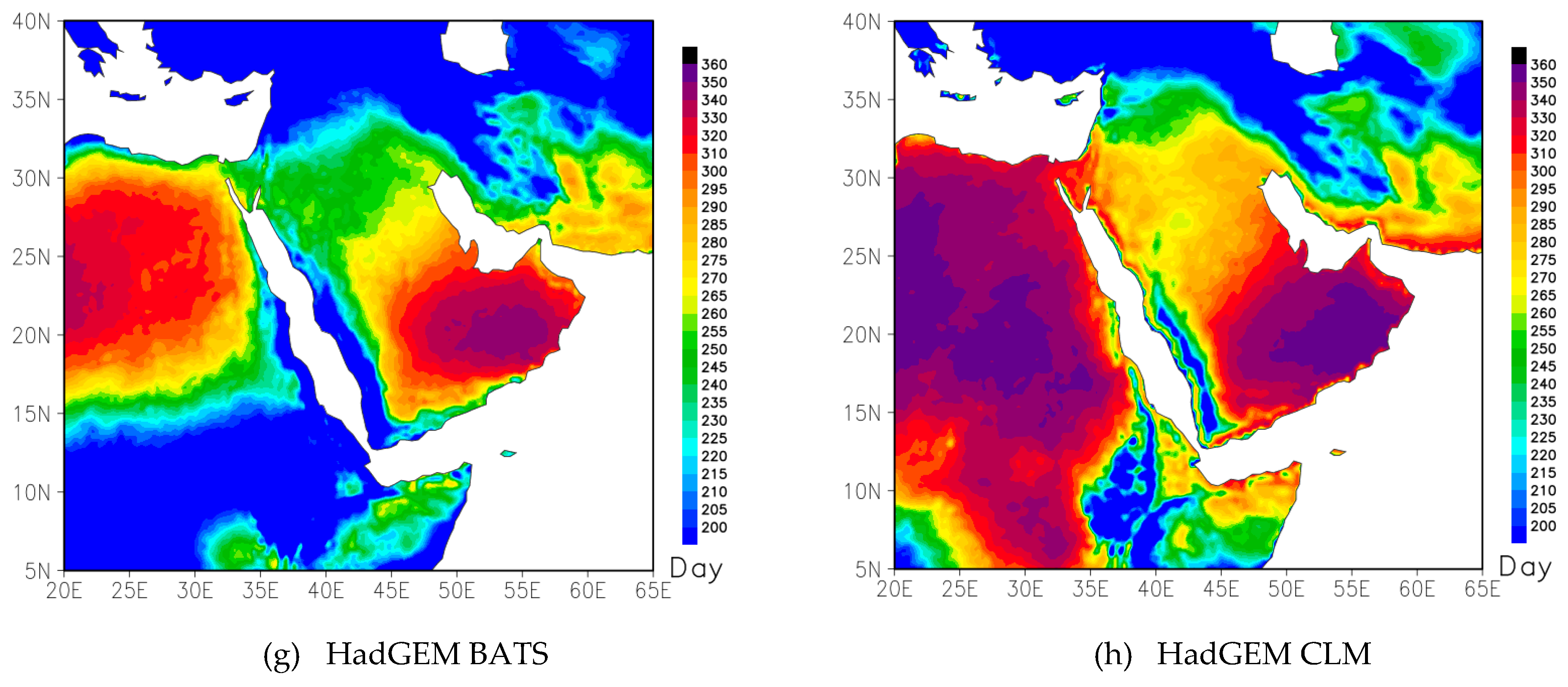
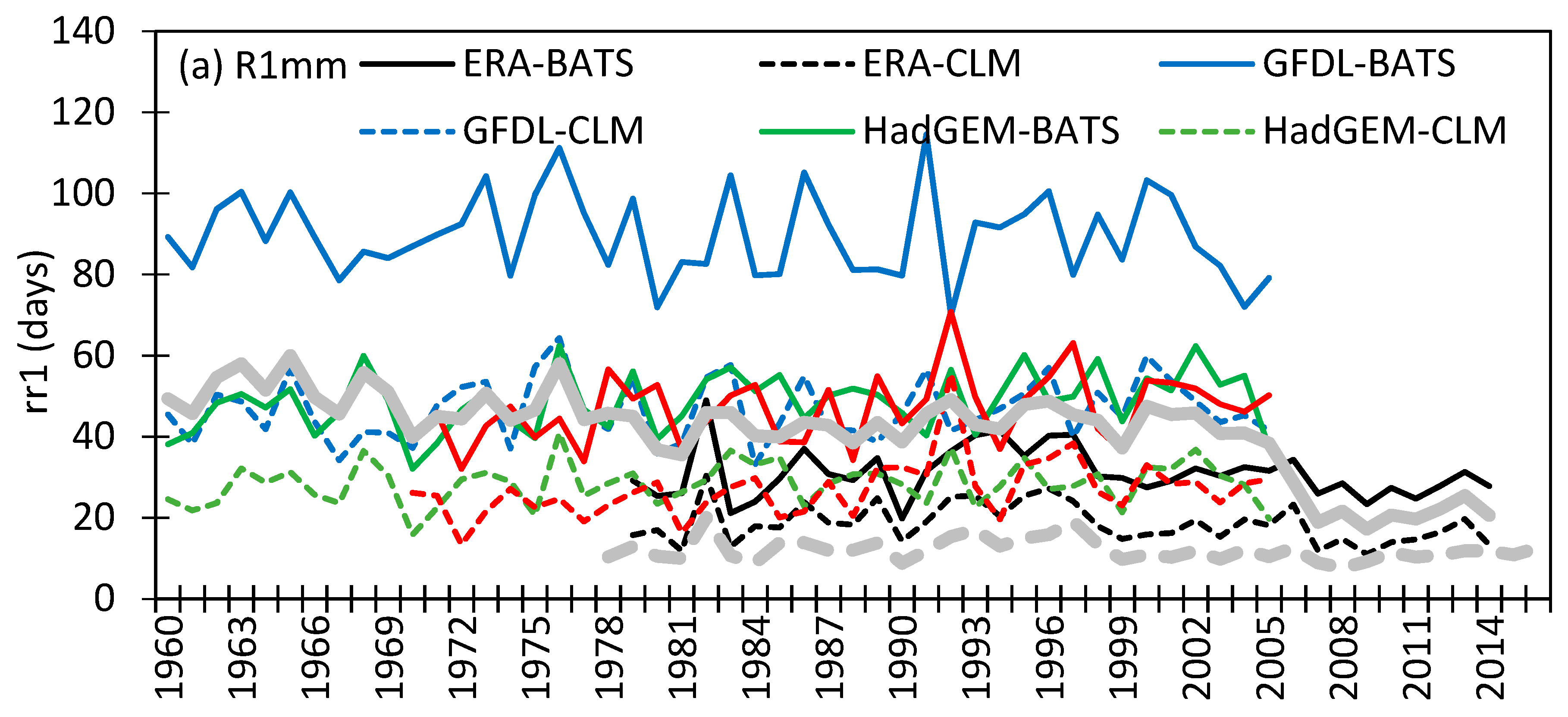
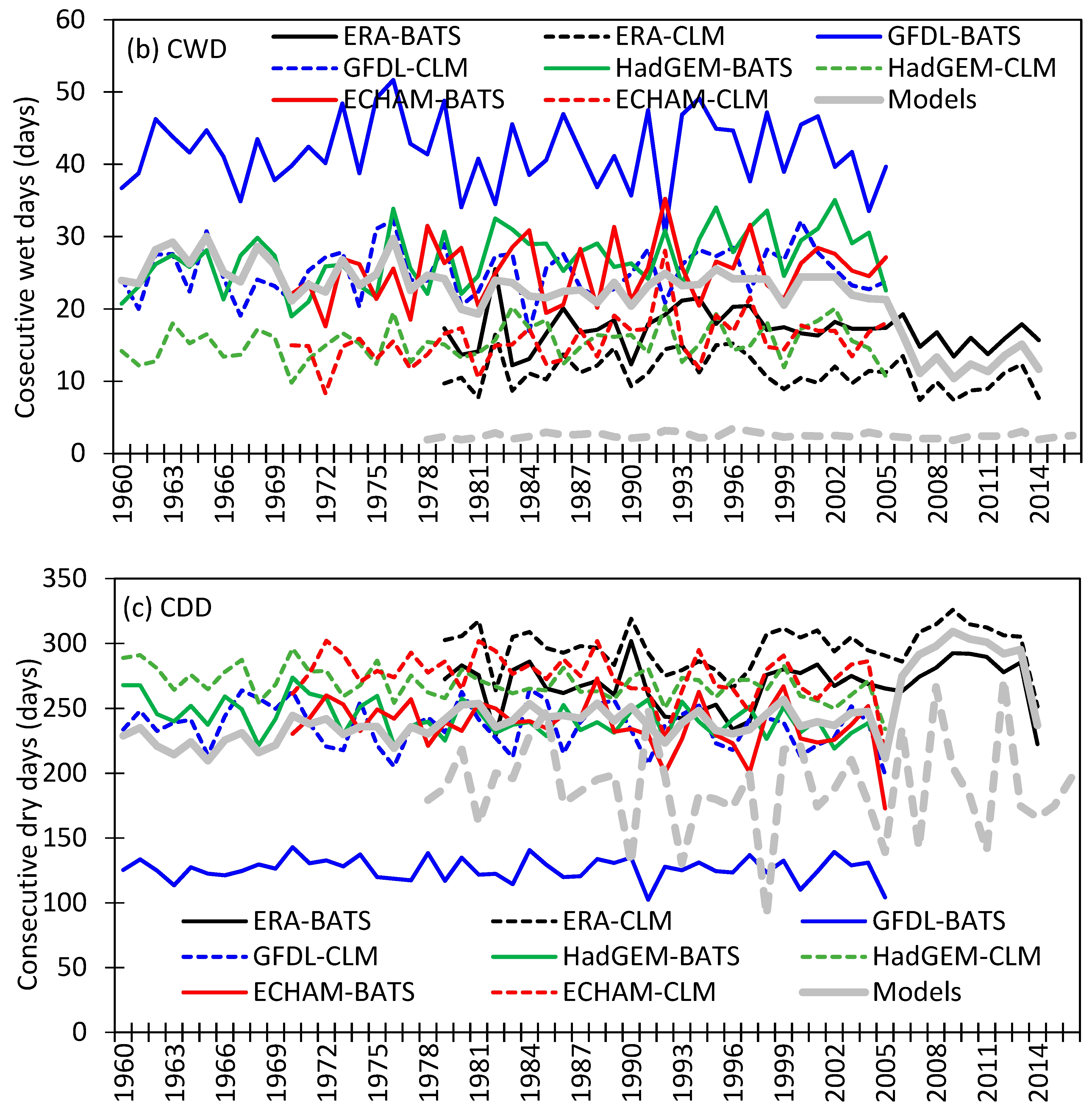
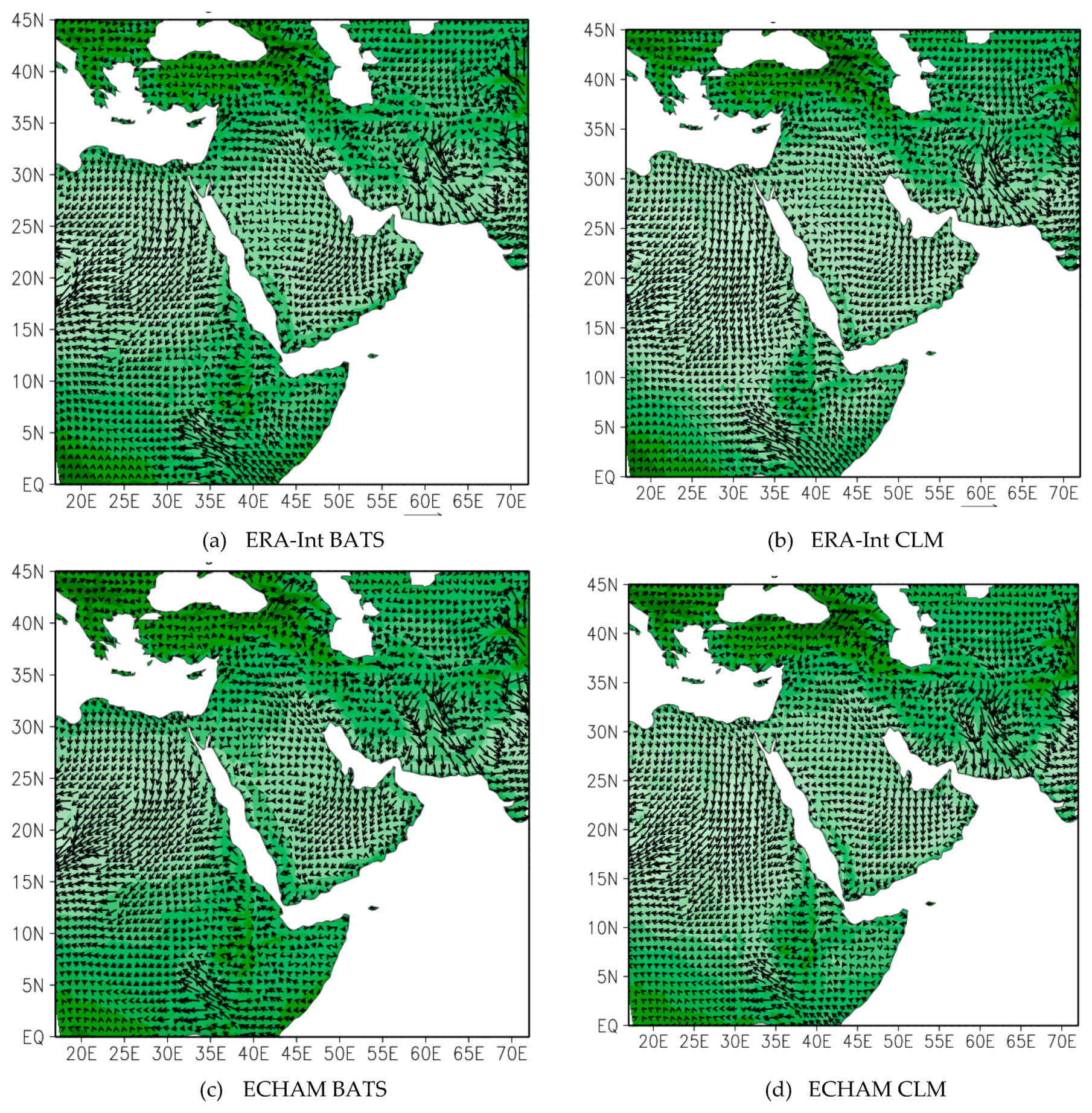
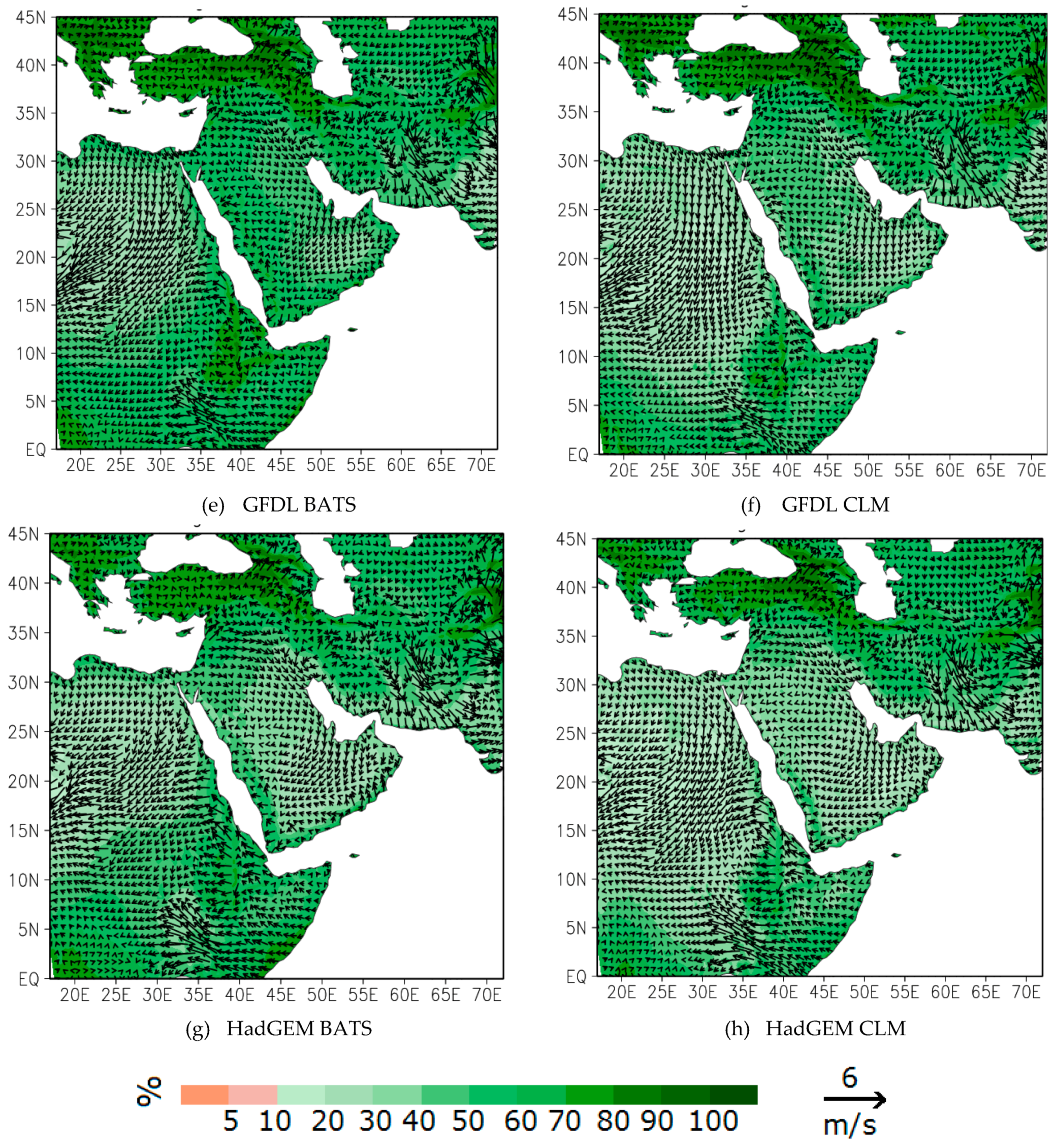
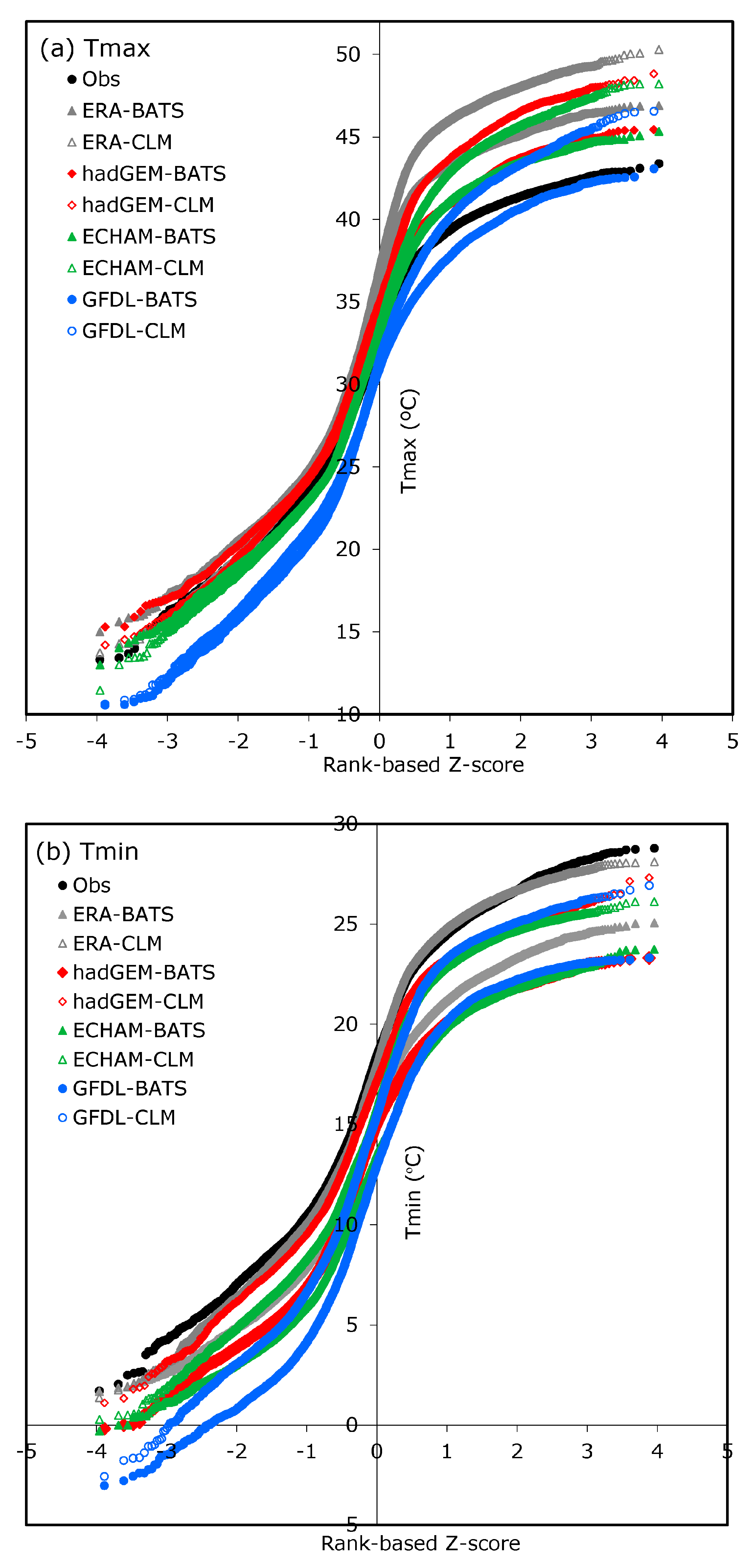

| Index Name | Index Label | Trend/Decade | p-Value |
|---|---|---|---|
| Summer days | su25 | 65.1 | 0.13 |
| Max TX | TXx | 5.7 | 0.13 |
| Min TX | TXn | 2.1 | 0.45 |
| Max TN | TNx | 7.2 | 0.07 |
| Min TN | TNn | 3.0 | 0.35 |
| Cold days | TX10p | −5.9 | 0.11 |
| Warm days | TX90p | 18.0 | 0.03 |
| Cold nights | TN10p | −7.5 | 0.05 |
| Warm nights | TN90p | 22.8 | 0.00 |
| Warm spell duration | WSDI | 75.8 | 0.06 |
| Cold spell duration | CSDI | −18.1 | 0.22 |
| Diurnal temperature range | DTR | −0.5 | 0.16 |
| Max 1 day precipitation | RX1day | 21.8 | 0.51 |
| Max 5 day precipitation | RX5day | 36.0 | 0.49 |
| Simple day intensity | SDII | 5.0 | 0.41 |
| Heavy precipitation days | R10mm | −2.0 | 0.40 |
| Very heavy precipitation days | R20mm | −0.1 | 0.45 |
| Number of wet days | R1mm * | −3.2 | 0.39 |
| Consecutive wet days | CWD | −0.4 | 0.52 |
| Consecutive dry days | CDD | −15.4 | 0.54 |
| Very wet days | R95p | 40.3 | 0.44 |
| Extremely wet days | R99p | 35.3 | 0.53 |
| Total wet-day precipitation | PRCPTOT | −18.9 | 0.46 |
| ERA-BATS | ERA-CLM | GFDL-BATS | GFDL-CLM | HadGEM-BATS | HadGEM-CLM | ECHAM-BATS | ECHAM-CLM | All-BATS | All-CLM | All-Models | Observed | |
|---|---|---|---|---|---|---|---|---|---|---|---|---|
| TX90p | −1.2 | −2.5 | 5.9c | 6.4c | 10.0c | 7.9c | 5.4a | 4.6a | 5.1c | 4.1c | 4.6c | 32.3c |
| TN90p | 3.9 | 3.2 | 10.0c | 8.0c | 12.3c | 11.6c | 9.0c | 9.8c | 8.8c | 8.2c | 8.5c | 12.1c |
| TX10p | −2.2 | −2.2 | −3.7 | −0.3 | −2.6 | −3.7a | −3.5 | −1.3 | −3.0b | −1.9 | −2.5 | −9.6c |
| TN10p | −3.1 | −5.6a | −5.8a | −4.9a | −3.4 | −3.8a | −6.4b | −6.6b | −4.7c | −5.2c | −5.0c | −7.7c |
| WSDI | 0.1 | −0.2 | 1.3c | 1.2c | 2.5c | 1.7c | 1.1 | 0.9a | 1.2c | 0.9c | 1.1c | 5.6c |
| CSDI | −0.9 | −1.2 | −1.9b | −1.7b | −0.9 | −0.9 | −1.5b | −1.6b | −1.3c | −1.4c | −1.3c | −1.6c |
| R1mm | 1.1 | −0.1 | 0.6 | 2.0 | 1.3 | −0.3 | 2.1 | 2.1 | 1.3 | 0.9 | 1.1 | −0.3 |
| CDD | −0.5 | −0.9 | −1.1 | −7.4 | −5.7a | −5.4a | −9.4a | −9.4a | −4.2 | −5.8b | −5.0a | −12.2 |
| CWD | 0.7 | −0.1 | 1.0 | 1.2 | 1.1 | −0.1 | 0.5 | 0.9 | 0.8 | 0.5 | 0.7 | 0.1 |
© 2019 by the author. Licensee MDPI, Basel, Switzerland. This article is an open access article distributed under the terms and conditions of the Creative Commons Attribution (CC BY) license (http://creativecommons.org/licenses/by/4.0/).
Share and Cite
Almazroui, M. Climate Extremes over the Arabian Peninsula Using RegCM4 for Present Conditions Forced by Several CMIP5 Models. Atmosphere 2019, 10, 675. https://doi.org/10.3390/atmos10110675
Almazroui M. Climate Extremes over the Arabian Peninsula Using RegCM4 for Present Conditions Forced by Several CMIP5 Models. Atmosphere. 2019; 10(11):675. https://doi.org/10.3390/atmos10110675
Chicago/Turabian StyleAlmazroui, Mansour. 2019. "Climate Extremes over the Arabian Peninsula Using RegCM4 for Present Conditions Forced by Several CMIP5 Models" Atmosphere 10, no. 11: 675. https://doi.org/10.3390/atmos10110675
APA StyleAlmazroui, M. (2019). Climate Extremes over the Arabian Peninsula Using RegCM4 for Present Conditions Forced by Several CMIP5 Models. Atmosphere, 10(11), 675. https://doi.org/10.3390/atmos10110675




